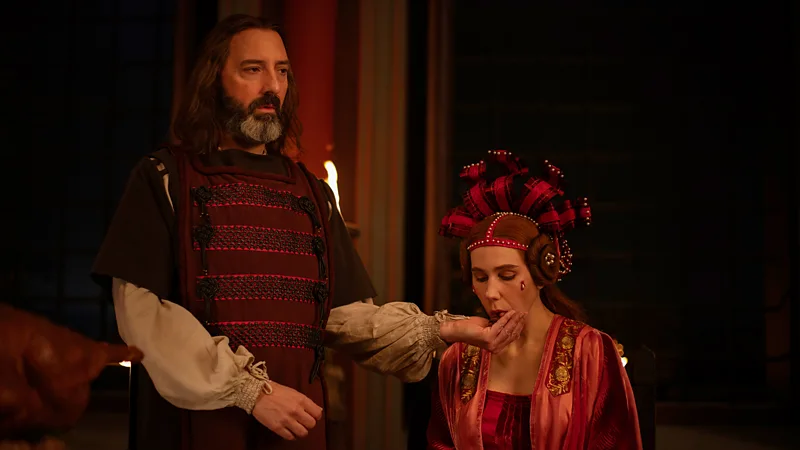“The False Healer: Martellino’s Deceptive Act”

Introduction
The tale of Martellino from Giovanni Boccaccio’s The Decameron is a witty and ironic story about deception and its consequences. In this story, Martellino pretends to be paralyzed in order to gain access to the body of a saint and stage a miraculous healing, only to face suspicion and danger when his ruse is uncovered. This tale not only entertains with its clever plot and humor but also critiques human gullibility and the unpredictability of fortune. The focus of this analysis is to explore how Boccaccio uses literary elements and character motivations to highlight timeless themes that remain relevant today.
Summary
Martellino and his friends travel to Treviso to see the body of the recently deceased saint, St. Arrigo, but the church is too crowded to enter. To get inside, Martellino pretends to be paralyzed, and his friends carry him in as if he needs healing. Once inside, Martellino pretends to be miraculously cured after touching the saint’s body, fooling the crowd. However, his deception is soon discovered, and he is accused of mocking the saint and causing outrage. Facing danger and arrest, Martellino is saved only through the quick thinking of his friends, who manage to trick the authorities and secure his release.
Analysis
Boccaccio’s tale of Martellino is a prime example of his skillful use of irony, satire, and comedic structure to explore human nature and social dynamics. The story functions as a humorous cautionary tale, where cleverness is initially rewarded but eventually turns against the deceiver. The plot is tightly constructed, relying on misunderstanding and reversal to build tension, while the narrator’s tone remains light and ironic. Boccaccio’s use of dialogue and swift pacing keeps the story engaging, while the humorous climax and resolution underscore the theme of unpredictability in human affairs.
Martellino’s motivation is driven by curiosity and vanity. He and his companions want to see the saint’s body, but more than that, they want to prove their cleverness by outwitting the crowd. Martellino's feigned paralysis is not just a means to an end—it’s a performance, showing off his theatrical flair and confidence in his ability to manipulate others. However, this hubris leads to his near downfall. When the crowd turns on him, he quickly shifts from clever trickster to desperate victim, revealing how easily fortune can reverse itself.
The story explores several themes, including deception, religious hypocrisy, and the fickleness of fortune. While Martellino’s actions are dishonest, the reaction of the crowd and the legal authorities also reveals a society quick to believe in miracles and equally quick to condemn. Boccaccio subtly critiques the blind enthusiasm surrounding relics and saints, suggesting that people’s desire to witness miracles can be manipulated and even dangerous. The story also touches on the fragility of reputation and justice, as Martellino’s fate swings wildly based on appearances and quick judgments.
Though set in the 14th century, the story remains relevant today. It speaks to contemporary concerns about the power of appearances, the risks of deception, and the social consequences of mass hysteria. In an age of misinformation and viral stories, Martellino’s tale reminds us how easily truth can be distorted and how quickly public opinion can shift. Ultimately, Boccaccio presents a world where wit is valuable but never fully safe, and where even the cleverest schemes can collapse under the weight of their own deception.
Personal response
What stood out to me most about Martellino’s story was the cleverness mixed with the consequences of his deceit. I found it both funny and thought-provoking how a seemingly harmless prank quickly spiraled into a serious and dangerous situation. I enjoyed the story because it balances humor with a sharp social critique, showing how easily people can be fooled and how unpredictable human reactions are. It made me reflect on how often people play roles or pretend to be something they’re not, sometimes with surprising or unintended results. Overall, the story’s wit and the way it highlights human folly kept me engaged and entertained.
Conclusion
Martellino’s tale cleverly combines humor, irony, and social commentary to reveal timeless truths about human nature—our tendency toward deception, our eagerness to believe in miracles, and the unpredictability of fortune. Despite being set centuries ago, the story remains relevant because it highlights how appearances can be manipulated and how quickly public opinion can shift, especially in moments of mass excitement or fear. In today’s world of misinformation and social media, Boccaccio’s tale reminds us to question what we see and hear, and to be wary of both deception and blind faith. This enduring relevance is what makes the story an important and insightful piece of literature.








